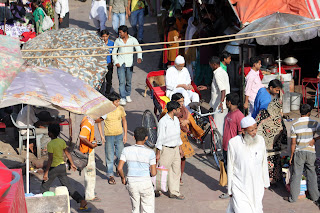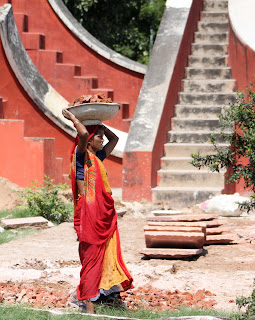
Today's random traffic sighting:
Crowded public conveyance? No worries--you don't need to be inside the vehicle.


 Horses drinking out of bathtubs, that is not something you see every day. I really wanted a better picture of this street lined with thirsty horses and their bathtubs--but I was in a moving vehicle.
Horses drinking out of bathtubs, that is not something you see every day. I really wanted a better picture of this street lined with thirsty horses and their bathtubs--but I was in a moving vehicle. Crows are not unusual, nor are they out of place around here.
Crows are not unusual, nor are they out of place around here. In the late afternoon sun, sandstone is scorching. But that doesn't mean you don't have to remove your shoes to enter the Jama Masjid.
In the late afternoon sun, sandstone is scorching. But that doesn't mean you don't have to remove your shoes to enter the Jama Masjid.
 The biggest mosque in Delhi.
The biggest mosque in Delhi.

 Out side the Jama Masjid is teeming with people. Shoppers. Worshippers. Pray-ers. Sellers. Beggars. Cyclers. Sitters. Standers. Loiterers.
Out side the Jama Masjid is teeming with people. Shoppers. Worshippers. Pray-ers. Sellers. Beggars. Cyclers. Sitters. Standers. Loiterers. 
 For this small-town girl new to India and Delhi, the Jama Masjid was one of my first and most overwhelming stops.
For this small-town girl new to India and Delhi, the Jama Masjid was one of my first and most overwhelming stops. 

 But right now there is work in progress to keep the monument restoration in repair.
But right now there is work in progress to keep the monument restoration in repair. Much of it is being done by this brick carrying lady.
Much of it is being done by this brick carrying lady.

 When I showed up at India Gate this morning, there was a military drll in progress. I missed its significance, what they were practicing for:
When I showed up at India Gate this morning, there was a military drll in progress. I missed its significance, what they were practicing for: One of the little observations I liked the most was that there was a Commander (the one in the turban) making sure the hand placement of the bugle players was adjusted just so.
One of the little observations I liked the most was that there was a Commander (the one in the turban) making sure the hand placement of the bugle players was adjusted just so. Apparently very important.
Apparently very important.

 Well not this lady, she's been here gardening forever.
Well not this lady, she's been here gardening forever. She told me I could take her picture if I gave her a good tip.
She told me I could take her picture if I gave her a good tip. Painting and
Painting and  chiseling of things, making that chink chink chink sound of metal on stone which causes me think of elves.
chiseling of things, making that chink chink chink sound of metal on stone which causes me think of elves.
 And the last "new" thing to see there was this funny group of school kids on a field trip. Part of what they got to see on their outing was a couple of foreigners who obligingly shook hands and practiced English with every one of them who dared to be so brave.
And the last "new" thing to see there was this funny group of school kids on a field trip. Part of what they got to see on their outing was a couple of foreigners who obligingly shook hands and practiced English with every one of them who dared to be so brave.

 Please note their safety gear and the special safety precautions taken.
Please note their safety gear and the special safety precautions taken. Ow.
Ow.
 across from the barber,
across from the barber, Dozens of washtubs and wash men cleaning clothes which fill the street to dry.
Dozens of washtubs and wash men cleaning clothes which fill the street to dry. Today, it seems, was a load of whites.
Today, it seems, was a load of whites.
"[There is] no regard for personal dignity and no respect for honest hard work. Merit is irrelevant in the culture of corruption, only appeasement matters.”
"He [Anna Hazare] is indeed following our great men and the gods that our sages created. They crafted our myths and legends – our folk literature – in their self-interest."
"In order to eradicate corruption, we need a different Messiah: one who would not extract his ‘pound of flesh’ but sacrifice himself for our salvation. We need a Savior who is a shepherd, who would redefine our cultural idea of leadership as servanthood."It is possible to get rid of corrupt officials and jail corrupt ministers, but the challenge is to change a culture.
 from the corn-roasting lady is a coffee stall.
from the corn-roasting lady is a coffee stall. I've ever seen a coffee place like this.
I've ever seen a coffee place like this. So I looked it up and found some interesting information on the Coffee board.
So I looked it up and found some interesting information on the Coffee board.